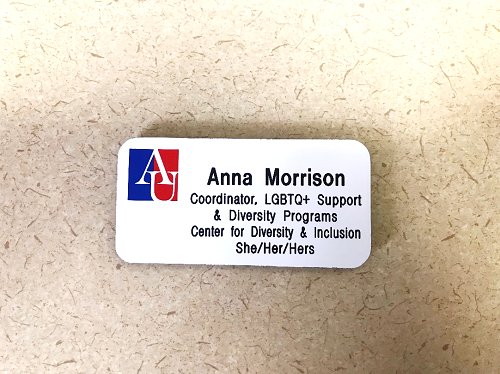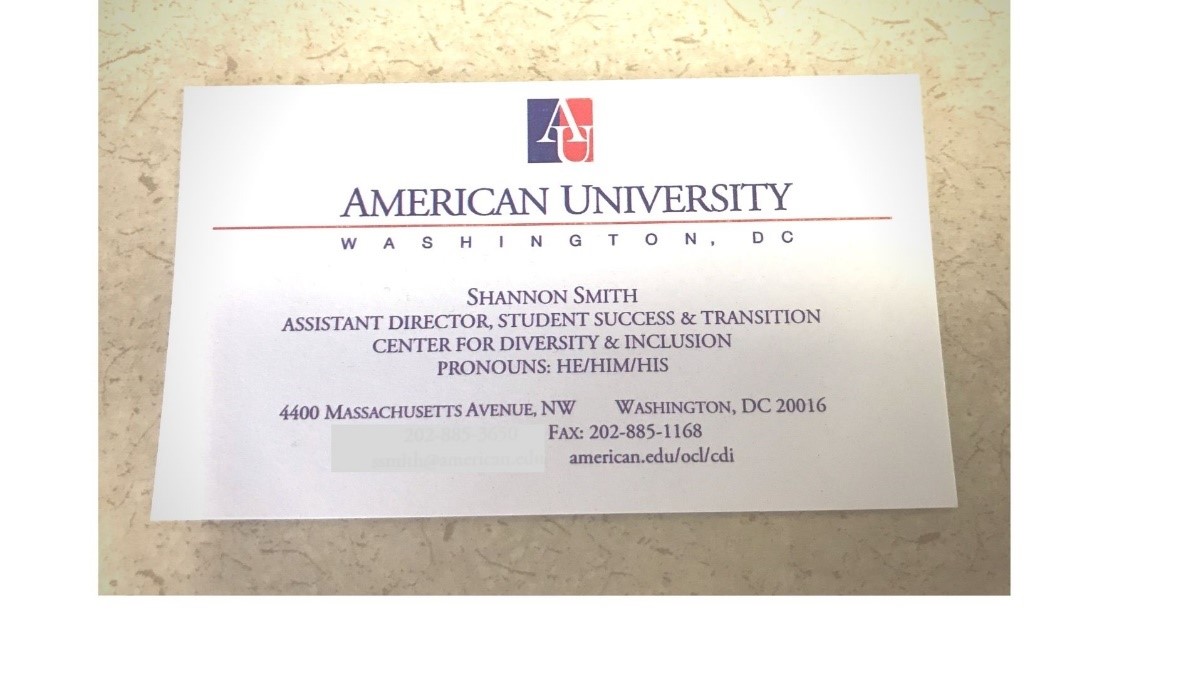You are here: American University Student Affairs Diversity and Inclusion Pronouns Guide
Contact Us
Monday-Friday, 9am - 5pm
Mary Graydon Center, Room 201 and 202 on a map
Center for Diversity and Inclusion 4400 Massachusetts Avenue NW Washington, DC 20016 United StatesWhat Are Pronouns?
Here’s our guide on what pronouns are, why they matter, and how to use new ones and support your trans friends! http://minus18.org.au/pronouns
Pronouns: A Guide for the American University Community
Pronouns are everywhere. We use them every day in speech and in writing to take the place of people’s names. We use them without even thinking about it. Pronouns may not seem like that big of a deal, but for some people, pronouns are a big deal because other folks don’t always use the correct pronouns to describe them. The practice of sharing and inviting others to share what pronouns they use for themselves should be done in an effort to respect the diversity of gender identities beyond man and woman. The following guide is a starting point for using pronouns respectfully.
What is a pronoun?
- A pronoun is any word that can replace a noun or noun phrase (I, you, them).
- Pronouns refer specifically to people that are being talked about (he, she, him, her, they, them).They are pronouns that an individual identifies with and would like others use to when talking to or about that individual.
What kind of pronouns can be used?
*Don’t assume the gender of a pronoun: she/her/hers are NOT “female” pronouns, and he/him/his are NOT “male” pronouns.
| Subject Pronoun | Object Pronoun | Possessive Pronoun | Reflexive Pronoun |
|---|---|---|---|
| ___ is an activist | I am proud of ___ | That is __ book and That book is ___ | That person likes ___ |
| She | Her | Her/Hers | Herself |
| He | Him | His | Himself |
| Ze* | Hir | Hir/Hirs | Hirself |
| Ze* | Zir | Zie/Zirs | Zirself |
| E or Ey | Em | Eir/Eirs | Eirself or emself |
| Per | Per | Per/Pers | Perself |
| They (are)** | Them | Their/Theirs | Themselves |
| Name | Name | Name's/Name's | Name |
Note: This chart is not the absolute guide to pronouns – always ask what someone’s pronouns are, and if it’s something you’ve never heard of, ask for clarification. Need some practice? Visit www.practicewithpronouns.com
*Additional alternate spellings for “ze” are “zie”, “sie”, “xie”, and “xe.” **When using “they” as a singular gender inclusive pronoun, you would still conjugate associated verbs as you would for the plural version, as in “they are an activist” or “they like to go shopping”, not “they is an activist” or “they likes to go shopping.” ***Never argue with or question a person’s gender identity of pronouns.
How should I ask what someone’s pronouns are?
- If you are in private with an individual, you can simply say, “Can I ask what your pronouns are?”
- Other ways of asking an individual their pronouns respectfully are: “How would you like me to refer to you?”;“How would you like to be addressed?”
- Often, offering up your own pronouns makes space for others to do the same if they are ready to. For example, “My name is Isaac and my pronouns are he and him.”
- This may feel uncomfortable at first, but you do not want to say the wrong pronouns based on assumptions, and the student will most likely appreciate your effort.
- Be sure to not just ask the gender ambiguous folks – ask everyone so as not to single anyone out.
- If you are in a group setting, examine first whether this is a safe place for students to potentially out themselves. This means examining power structures—is a student going to worry about their grades being lowered or losing a job/friends/family?
- Never make group pronoun sharing a requirement. Some people’s identities will be validated by sharing their pronouns. For others who may be questioning identities, making sharing pronouns mandatory feel constricting.
- You can also ask about pronouns as part of a group exercise, which would allow you to explain to the group what pronouns are. You could say something like: “Everyone tell your name, a fun fact about you, and your pronouns if you’d like to share. For example, my pronouns are she, her, and hers.”
- If you’re creating name tags for an event, put a space on the nametag, or add into the sign-in instructions for folks to share their name and pronouns if they’d like.
- If you make a mistake: Mistakes happen! If you use the wrong pronoun, apologize and correct it, and then move on. Avoid continually talking about how bad you feel for making the mistake, because it makes the person feel like they need to console you. If you forget someone’s pronouns, follow the same protocol: apologize, correct it, and move on.
- If someone is using the wrong pronoun for a person, correct it by saying something like, “Actually, Alex uses the pronoun she.” If folks continue to use the wrong pronoun, do not ignore it. It might help to ask the individual who has been misidentified if they would like you to take the person aside and remind them of the proper pronoun.
Should I use the term “preferred” or just ask for someone’s name or pronouns?
Many people find the use of "preferred" to describe names and pronouns insulting. It is not someone’s “preferred” name, it is their name. Likewise, it is not someone’s “preferred” pronouns, but the pronouns that they use.
Why is it important to respect and continually make space for others to share pronouns?
- Inquiring about pronouns is a simple way to show you want to cultivate an environment that respects all gender identities.
- You can’t always tell someone’s pronouns by looking at a person.
- For those in positions of power, by respecting one’s pronouns consistently, you set an example for peers and other students.
- For some folks who use multiple pronouns or whose pronouns change over time, having the opportunity to share what pronouns are affirming on a consistent basis is important.
- When someone is referred to by the wrong pronoun, it can make the person feel disrespected and alienated.
Pronouns are for everyone!
We encourage all people—regardless of gender identity or expression—to share their pronouns before presentations, on slideshows, in email signatures, and on business cards. Normalizing these practices creates a culture of respect where every person is involved in sharing pronouns, not just those who are misgendered. Here are some examples:
Example of a nametag with pronouns example:

Example of an office name plate with pronouns:

Example of a business card with pronouns:
 Example of an email signature with pronouns:
Example of an email signature with pronouns:

It can be tough to remember pronouns at first. The best solution is to practice! Correct pronoun use is an easy step toward showing respect for people of every gender!
